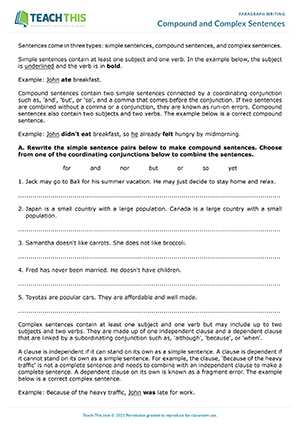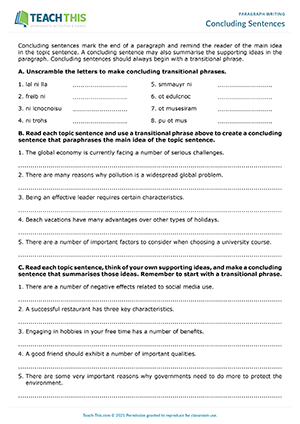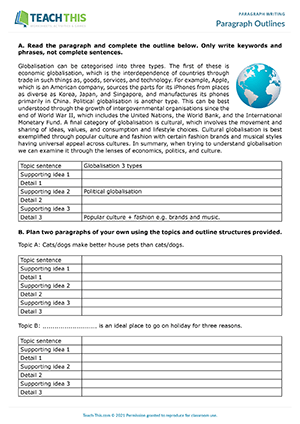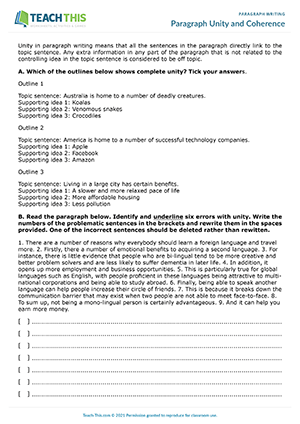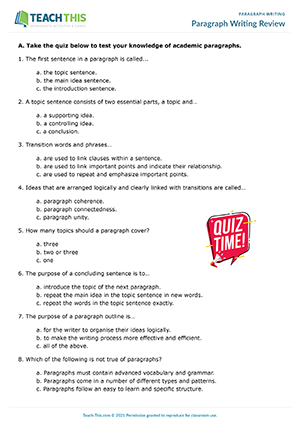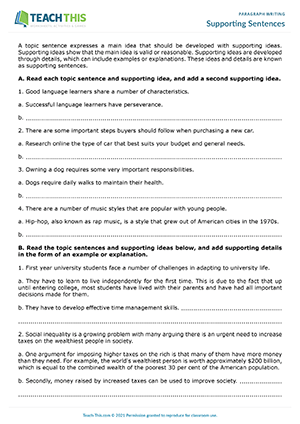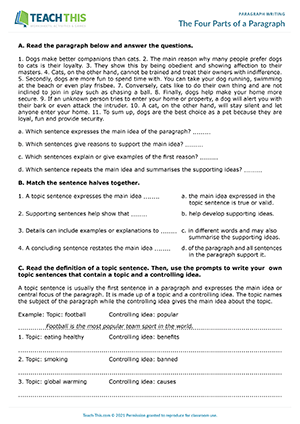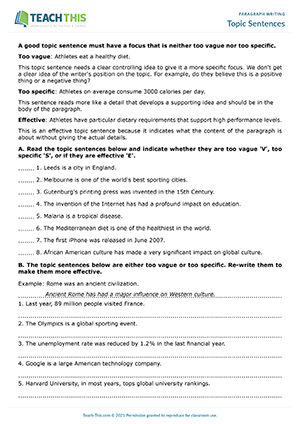In this insightful compound and complex sentences worksheet, students review and practice sentence structure and sentence types. Students begin by reading about the characteristics of simple and compound sentences. Students then rewrite pairs of simple sentences to make compound sentences with coordinating conjunctions. Next, students read information about complex sentences. Students then combine pairs of simple sentences to make complex sentences using subordinating conjunctions. In the last exercise, students read a paragraph to identify run-on and fragment errors and then rewrite the paragraph so that the sentences are correct.
In this handy concluding sentences worksheet, students practice writing concluding sentences by restating topic sentences and summarising supporting ideas. To start, students read about concluding sentences and unscramble letters to make concluding transitional phrases. Students then read each topic sentence shown and use a transitional phrase to create a concluding sentence that paraphrases the main idea of the topic sentence. Next, students read topic sentences, think of their own supporting ideas and use transitional phrases to make concluding sentences that summarise those ideas. After that, students read paragraphs and add a concluding sentence that either restates the topic sentence or summarises the supporting ideas. Finally, students read topic sentence and concluding sentence pairs, and try to identify any errors in the concluding sentences. If students find any errors, they highlight them and rewrite the concluding sentence to make it more suitable.
In this free paragraph outlines worksheet, students practice using outlines to structure and write paragraphs. To start, students read an example paragraph and complete a paragraph outline with the supporting ideas and details from the text. Next, students follow the example and plan two paragraphs of their own using the topics and outline structures provided. Students then choose one of the topics from the previous exercise and use the outline to write a paragraph. Finally, students do a peer review exercise where they swap paragraphs with a classmate and use a paragraph writing checklist to give each other feedback.
In this comprehensive paragraph unity and cohesion worksheet, students analyse and revise a paragraph with unity problems and complete another paragraph to improve its coherence with transition words and phrases. Firstly, students read an explanation of unity in paragraph writing. Students then choose the outline that has complete unity. Next, students read a paragraph and identify six errors with unity. Students then rewrite the problematic sentences and choose the sentence that does not belong in the paragraph. After that, students read about coherence in paragraph writing. Students then add transition words and phrases to a table according to their function. Finally, students complete a paragraph by adding appropriate transition words and phrases to improve its coherence.
In this useful paragraph writing review worksheet, students revise academic paragraph structure and writing. First, students complete a multiple-choice quiz to test their knowledge of academic paragraphs. Students then complete missing parts of a paragraph with a suitable topic sentence, a supporting idea, and a concluding sentence. In the last exercise, students read a paragraph to find errors with unity and coherence. Students then rewrite the paragraph making the necessary improvements.
In this in-depth supporting sentences worksheet, students practice developing a main idea expressed in a topic sentence through supporting ideas and details. First, students read about supporting ideas and details. Students then read each topic sentence and supporting idea, and add a second supporting idea. Next, students read the topic sentences and supporting ideas provided, and add supporting details in the form of an example or explanation. Finally, students use the prompts provided to write a topic sentence, a supporting idea, and supporting details.
In this free paragraph structure worksheet, students review the four basic parts of an academic paragraph and practice writing topic sentences, supporting ideas, supporting details, and concluding sentences. Students begin by reading a paragraph to identify its basic structural components. Students then match sentence halves to reveal an explanation of each part of a paragraph. Next, students read a definition of a topic sentence and use prompts to write their own topic sentences that contain a topic and a controlling idea. After that, students use the topic sentences provided to write a supporting idea that is then developed further with either an example or an explanation. Finally, students paraphrase topic sentences in their own words to make concluding sentences using the transition phrases: In conclusion, In summary, or To sum up.
In this productive topic sentences worksheet, students learn to identify and produce effective topic sentences. Students start by reading notes on ineffective versus effective topic sentences. Next, students categorize sample topic sentences as either being vague, specific, or effective. Students then examine more sample topic sentences that are either vague or specific and re-write them so that they are effective. Finally, students read paragraphs that are missing a topic sentence and write an effective topic sentence for each.
Latest Free
Resources
- Everyday Objects Bingo
Everyday Objects
Elementary (A1-A2)
- Action Verb Races
Actions
Elementary (A1-A2)
- Birthday Basics
Birthdays
Elementary (A1-A2)
- Sales Phrasal Verbs
Business Phrasal Verbs
Upper-intermediate (B2)
Latest Member
Resources
- Collocations at Work
Business Collocations
Intermediate (B1)
- Etiquette Trivia Board Game
Etiquette and Manners
Upper-intermediate (B2)
- Everyday Objects Vocabulary
Everyday Objects
Pre-intermediate (A2)
- Let's have a talk
Verb-Noun Collocations
Pre-intermediate (A2)



